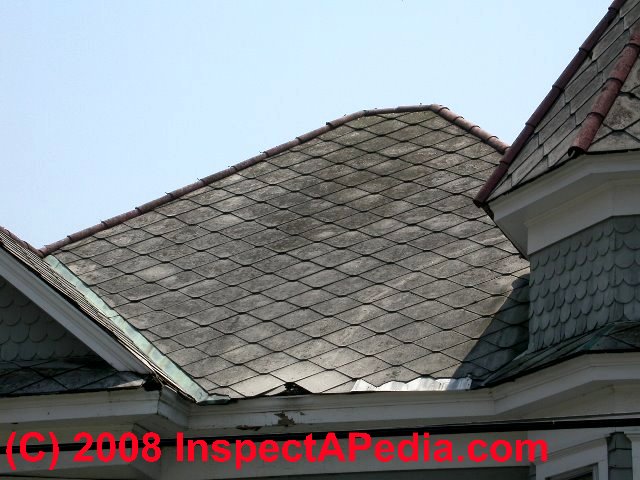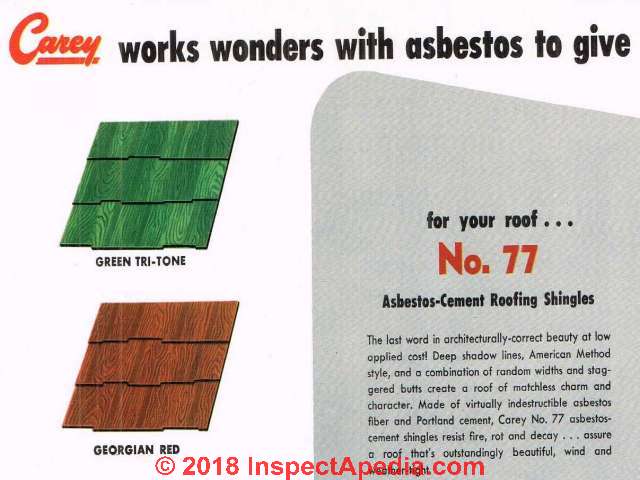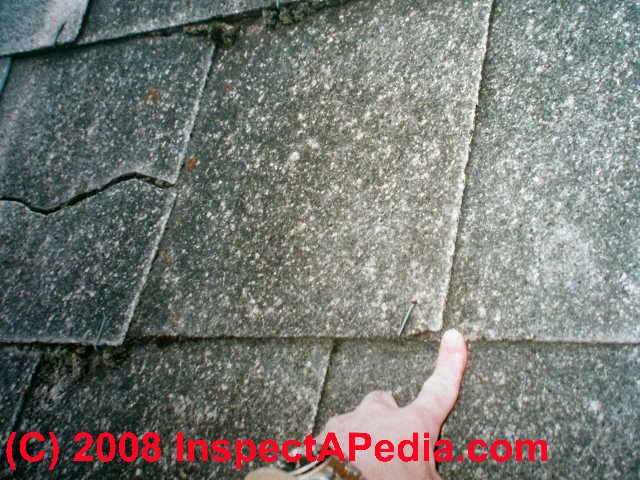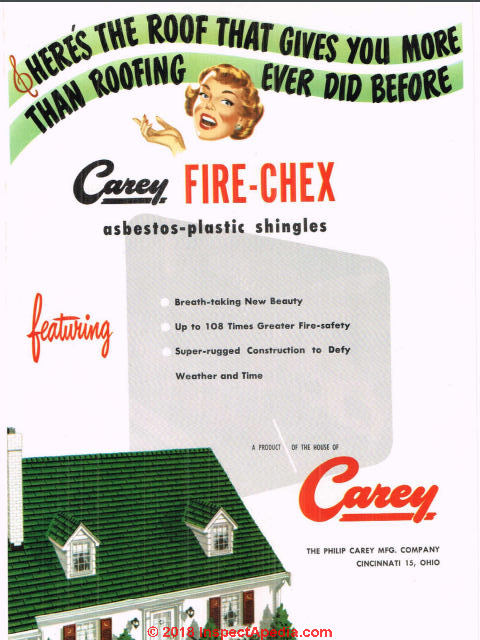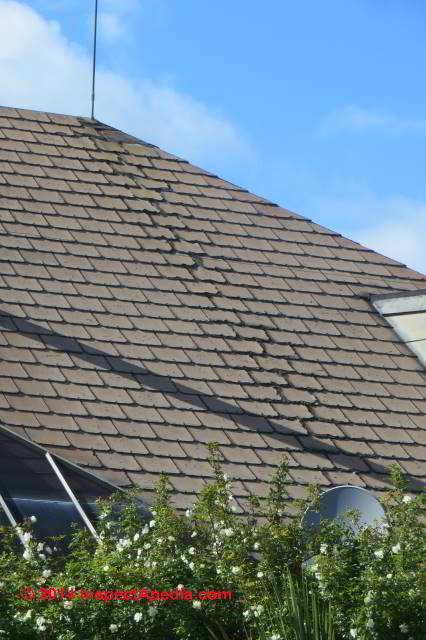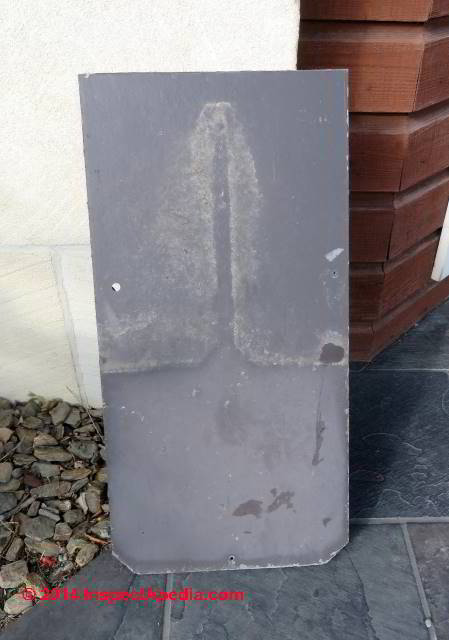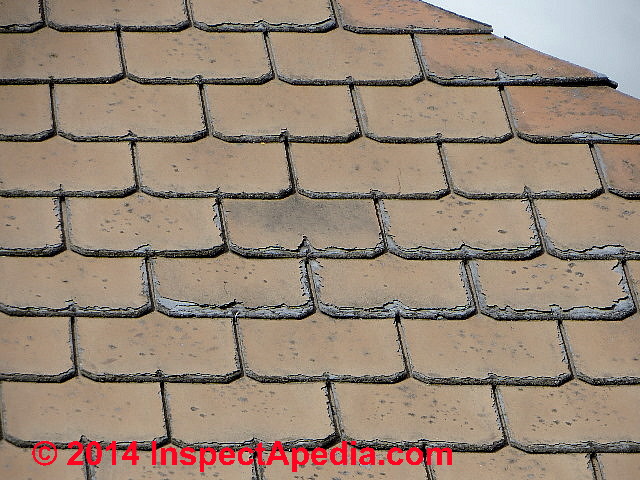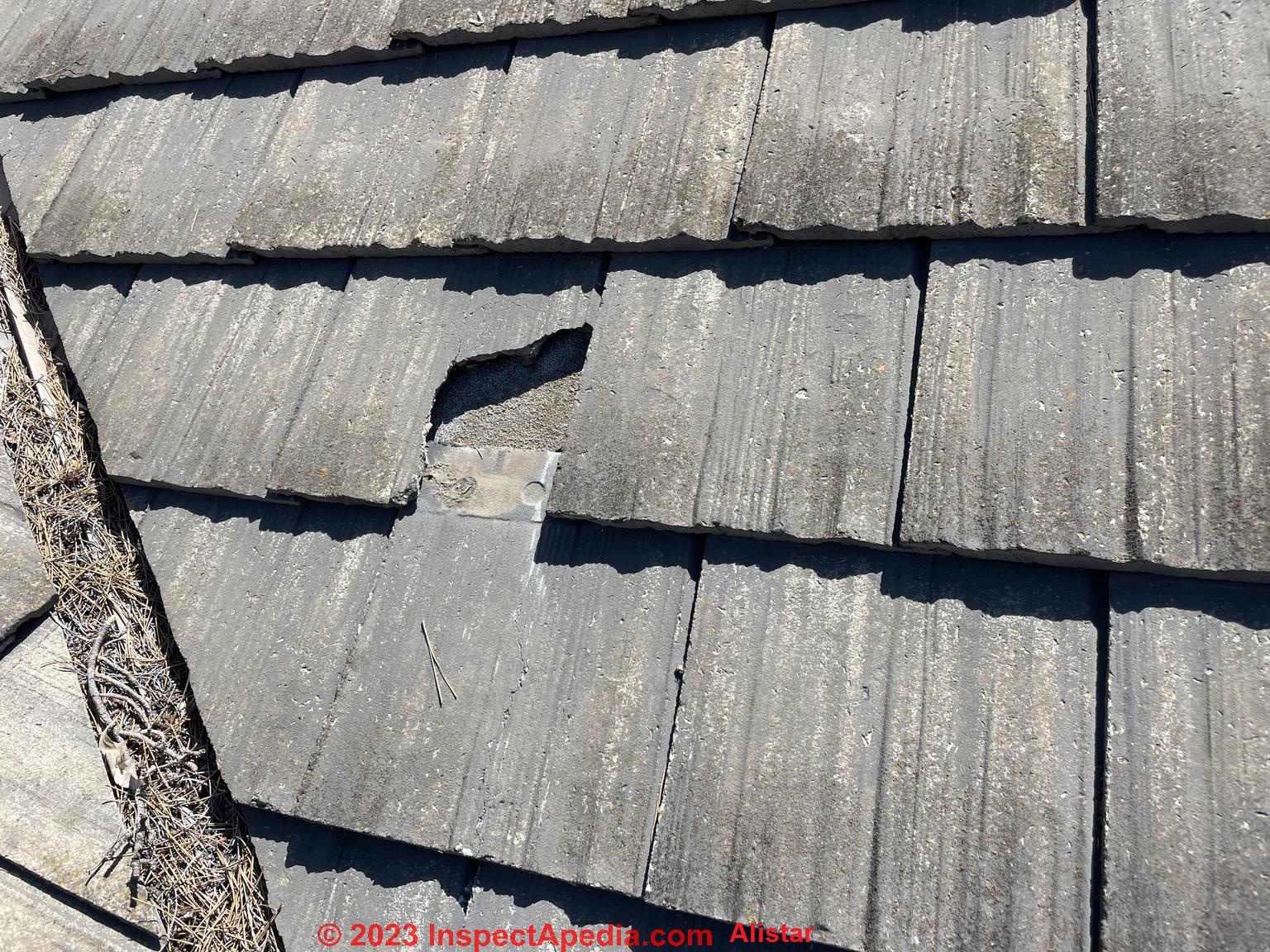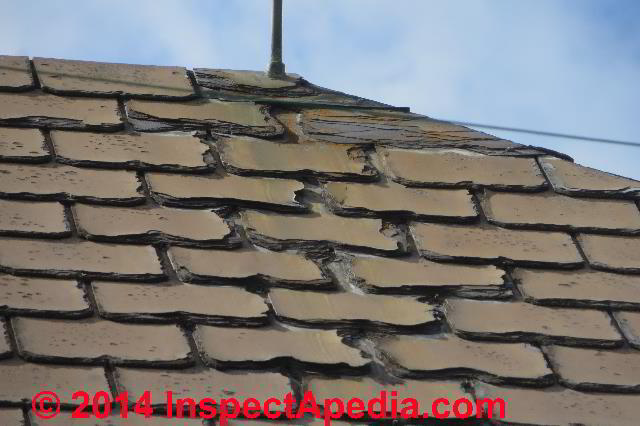 Asbestos-Cement & Modern Fiber-Cement Roofing
Asbestos-Cement & Modern Fiber-Cement Roofing
Identification, inspection, asbestos content, repair
- POST a QUESTION or COMMENT about asbestos cement roofing and its replacement products
Asbestos cement roofing: shingles, corrugated, other forms.
How to identify fibre cement roofing, how to repair or replace asbestos-containing roofing.
This article series provides a photo guide and text that can help in identification of asbestos-containing roofing products like asphalt shingles & asbestos-cement roof shingles.
Our page top photograph shows badly deteriorated fiber cement roof cladding installed on a motor lodge in Oamaru, New Zealand.
This roof was installed in 1986 and was the subject of a class action settlement. Interestingly, though identified by the building manager as a fiber cement product, this roof, from the ground, in its deteriorated condition this roof looks more like a wood-fiber shingle product than a cement-fiber shingle product.
Additional photographs of this roof and its cladding material are included in the article below. The author has installed, inspected, and repaired various types of asbestos cement roofs on buildings since 1978.
InspectAPedia tolerates no conflicts of interest. We have no relationship with advertisers, products, or services discussed at this website.
- Daniel Friedman, Publisher/Editor/Author - See WHO ARE WE?
Cement-Asbestos Roof Shingles,Tiles, or Corrugated Roofing: Photo guide to asbestos containing roofing products
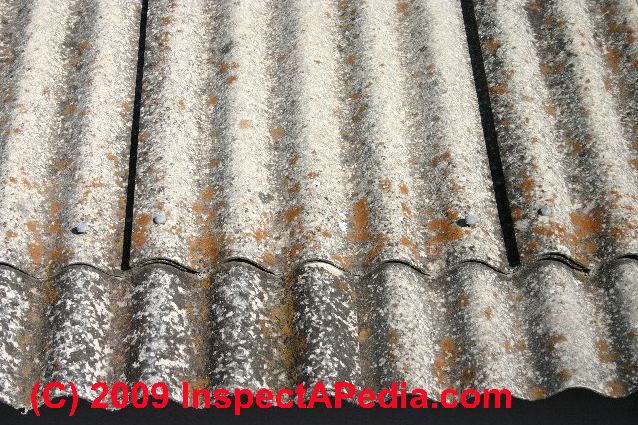 Here we discuss repair or replacement of asbestos-containing roof products, disposal of asbestos cement roofing debris and cleaning, safety, and maintenance of these roofs.
Here we discuss repair or replacement of asbestos-containing roof products, disposal of asbestos cement roofing debris and cleaning, safety, and maintenance of these roofs.
We include photographs of various asbestos-containing cementious roofing products such as asbestos cement shingles and corrugated asbestos cement roofing.
Photo just above: corrugated cement asbestos roofing on a building in Herefordshire in the U.K.
We also compare cementious fiber cement cladding with Masonite™ type wood fiber cladding products and we provide roof repair methods, suggestions, and regulations.
Article Contents
- ASBESTOS-CEMENT & FIBER CEMENT SHINGLE IDENTIFICATION
- CEMENT-ASBESTOS SHINGLE HISTORY
- CEMENT ASBESTOS CLAD / ROOFED HOME BUYER TIPS
- ENVIRONMENTAL ISSUES - ASBESTOS ROOFING / SIDING
- ASPHALT-ASBESTOS ROOFING MATERIALS
- FIBER CEMENT-ASBESTOS SHINGLE FAILURES & WEAR - Examples of asbestos cement roof damage or wear
- OSHA REGULATION OF ROOF DEMOLITION WHERE ASBESTOS CONTAINING ROOFING MATERIALS ACRM ARE PRESENT
- PAINTS & SEALANTS, ASPHALT-ASBESTOS
- WARRANTY & CLASS ACTIONS, FIBER CEMENT SHINGLES
The mixture of asbestos fibers and portland cement to form a hard material that was was durable and fire resistant is credited to Ludwig Hatschek who, in 1900, came up with the name Eternit associated with a U.S. producer of these products. Some fiber cement roofing contains asbestos while other products do not.
See CEMENT ASBESTOS PRODUCT MANUFACTURE for details of the Hatschek machine and its operation.
...
How to Recognize Asbestos Cement & Fiber Cement Roofing Products
While an expert lab test using polarized light microscopy may be needed to identify the specific type of asbestos fiber, or to identify the presence of asbestos in air or dust samples, many asbestos-containing building products not only are obvious and easy to recognize, but since there were not other look-alike products that were not asbestos, a visual identification of this material can be virtually a certainty in many cases.
Look for hard cementious shingles in rectangular or diamond shape as in our photo above (a home in Newburgh, New York), or for corrugated cement asbestos roofing shown earlier on this page.
For more photo-examples that can help you identify this roofing material, see the additional asbestos cement roofing photos below on this page.
Watch out: asbestos cement roofs are fragile and are easily damaged simply by trying to walk on them. Keep off unless you know how to provide a safe walking surface or scaffolding that will protect the roof surface from being broken by your weight.
Most roofing materials are considered to be non-friable, and are probably less hazardous than other friable asbestos products such as asbestos pipe insulation.
However removal of asbestos-containing roofing products is regulated as we discuss
...
Asbestos-Cement & Fiber Cement Roofing & Siding Colours & Patterns
Above: Carey No. 77 Asbestos-Cement roofing shingles shown in Green tri-tone and Georgian Red.
Amy Lamb Woods, in "Keeping a Lid On It" Asbestos-Cement Building Materials" provides a superb and concise description of the history and properties of asbestos cement building products, while beginning at ASBESTOS ORIGIN & NATURE we provide the compete text of Rosato's 1959 seminal work on this topic.
Originally, [cement asbestos] roof shingles were manufactured in three typical colors: natural cement gray, Indian red (tile), and blue - black (slate).
Two primary designs produced were Hexagonal (diamond shape) and Dutch lap (similar to wood shingles). Each [cement asbestos] shingle is held by two nails, with t he addition of a storm nail at the apex of the Hexagonal pattern.
They are much lighter than tile or slate and weigh only a little more than wooden shingles, allowing for a more economical substructure.
Other shapes include: Poilite Straight Cover Slating (square or chamfered corners), Scalloped (three or five scales to a tile), Bell's Pan (ogee shape, or a skewed pan tile), and Endurol (wave pan tile). When asbestos - cement roofing shingles were properly manufactured and installed, the shingles were so du rable that the roof would commonly outlast the functional lifespan of the building.
Asbestos-cement siding shingles imitated wood siding shingles in shape and appearance, typically available in sizes of twelve by twenty - four inches.
These shingles original ly came in nondescript tones like gray - green, gray - pink, and Dover white. Textures such as grooved, wood - grained, or smooth were pressed into the large asbestos - cement sheets, then cut to the profile of the design, such as Tapertex (flat horizontal lines), Thatched, or Waveline. - Woods (2000)
Current Fibre Cement Roofing
No modern contemporary fiber cement roofing or siding product is manufactured containing asbestos.
Fiber cement roofing products, a replacement that is similar in properties but that does not use asbestos, continue in popular and widespread use in the North America and many other areas of the world today. In some parts of the world, fibre cement cladding products are manufactured in compliance with Asbestos-free Standard ISO 9001:2008.
In the article series found at CONTINUE READING at the end of this article we provide photographs and descriptive text of asbestos insulation and other asbestos-containing products to permit identification of definite, probable, or possible asbestos materials in buildings.
However as we discuss at FIBERBOARD ROOFING & FIBER-WOOD ROOFING , even modern wood-cement and other fibre cement products are not impervious to deterioration or fungal growth.
Branko (2006) points out that in modern cement-bonded aggregate and fibre products, especially in prolonged-wet environments, particularly in wood-cement and straw-cement products (such as StrawCrete) the materials support fungal growths, even visible "mushrooms" such as the genus Peziza. - Branko (2006)
...
History of Cement-asbestos Shingles
Asbestos cement roof shingles were in popular use in the U.S. from the 1920's (est) through the 1960's (est) and were sold in the U.S. into the 1970's and according to some sources even in the 1980's.
The mixture of asbestos fibers and portland cement to form a hard material that was was durable and fire resistant is credited to Ludwig Hatschek who, in 1900, came up with the name Eternit associated with a U.S. producer of these products.
The typical life expectancy of an cement asbestos shingle roof was given as 30 years, but we've seen these roofs that were now 50 years old in good condition. Typical roof wear or failure patterns are either failure of the shingle fasteners or broken and falling shingles.
Asbestos cement corrugated roofing has been in use over the same time period and was generally a thicker material used in low-cost applications such as on sheds, barns, and low-income housing in some areas.
Roofing materials that use fibers and aggregate other than asbestos are properly called "fiber cement" roofing products.
Some manufacturers use the term "fiber-reinforced cement" for these products. All of these products use some sort of fiber along with cement. Before 1978 in the U.S. the common fiber used was asbestos.
Cement asbestos shingles (or asbestos cement roofing shingles) have a medium in-place cost and durability compared with other roofing products and a a fire rating of Class A or B.
Above is a clip from an advertisement for Carey Manufacturing's Fire-Chex Class-A rated plastic-asbestos coated roof shingles, -
see CAREY ROOFING CATALOG 1950 [PDF]
...
Cementious-based Fibre-Cement Roof Cladding Wear & Failure Examples
Above are additional photographs of the fibre cement roof shown at the top of this page.
Our photos of this New Zealand roof shows an interesting wear pattern that suggests that chemical or mineral down-wash from metal components installed at the ridge might have been a factor in this particular wear.
Above is a fibre cement roof shingle that was salvaged and doubtless is held for use in repairs. From a distance this product looks a lot like slate, doesn't it?
However these roof tiles were badly worn over many areas of the roof as we show at page top and below.
Unlike the Masonite Woodruf™ roofing discussed below, these delaminating cementious roofing tiles (or cladding, slates or shingles) are a cementious material reinforced with fibres. Early product versions used asbestos.
More contemporary fibre cement products use filler and reinforcement that does not include asbestos, commonly fibreglass. What about the shingles shown just above?
Watch out: from the ground it can be difficult to distinguish between wood-fiber based shingle products like the Masonite product described below, and fiber-reinforced cement shingles resembling the roofing shown above.
Taking an up-close look, even without magnification or forensic microscopy, the distinction between cementious fiber cladding and wood-fiber based cladding will be visually obvious - as you may notice in the Masonite Woodruf™ type shingles shown next.
These synthetic "slates" were installed in 1986 and were photographed (above) in 2014, making them 28 years old.
We were told by a tenant that the building owner received a settlement on this roof but has not replaced it. Lab samples of this roof cladding were tested, and results are now available.
See details at MANUFACTURED / SYNTHETIC SLATE ASBESTOS CONTENT where we report on testing this Omaru New Zealand synthetic roof slate for asbestos.
Also see SIDING, FIBER CEMENT IDENTIFICATION
Below: a damaged Permatek shake roof showing a broken asbestos-cement shake, and on closer examination, a few cracks and holes.
Details about inspecting and repairing this roof are
at PERMATEK SHAKE ROOF REPAIR METHODS
More asbestos-containing roof covering wear examples are
...
Guide to Asphalt-asbestos Roof Shingles, Roll Roofing & Roofing Mastics & Coatings
See our asphalt roofing materials articles
where you will read that some older asphalt based roofing products including shingles and roll roofing contained asbestos, most-often in the asphalt-impregnated felt backer.
...
Environmental Issues With Cement Asbestos Roof Shingles
How do we cut, install, or remove fiber cement roofing or siding products with a minimum of dust and potential asbestos fiber release? How friable are cement-asbestos roofing and siding products?
Definition of friable asbestos materials:
The asbestos in cement asbestos roofing products is not friable under normal conditions. That is, asbestos cement products are is not normally easily crushed into dust by hand.
Cleaning stains, mold algae, lichens from cement-asbestos roofs
Watch out: As we discuss at POWER WASHING ROOFS we do not recommend power-washing asbestos-cement nor any other roofing.
See BLACK STAIN REMOVAL & PREVNTION for advice on diagnosing, cleaning, and preventing stains on roofing.
Warning about making asbestos-containing cementious materials become friable
Watch out: However very old, weathered and worn asbestos cement shingles, such as on a roof or sometimes on a wall that has been painted and is peeling, or roofing or wall cement asbestos shingles that are mishandled during demolition (breaking into many small pieces, running hand or power saws to cut the material) risks creating airborne asbestos-contaminated dust which could be a health and environmental hazard.
See ASBESTOS ROOFING / SIDING DUST - separate article
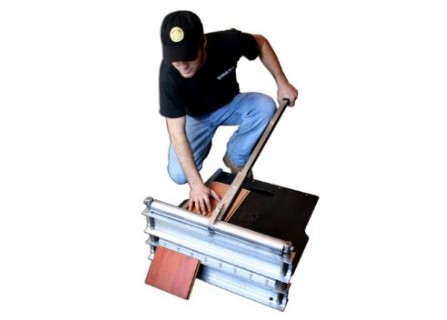
When we installed asbestos cement shingle siding we rented a guillotine chopper that cut the material while producing a minimum of dust.
A modern version of this fiber cement cutter that is hand-lever operated and does not require electricity is the Bullet Tools 920 Pro Magnum Shear I-20 Electricity Free 20 Inch Flooring and Siding Dust Free Cutter (photo at left) - this is a great tool, but a bit steep for a homeowner or do-it-yourselfer at around $900. \
A modern fiber cement shingle cutting tool used for the same purpose is the Malco® TSFC Tubo Shear fiber cement cutting tool also used to cut cement backerboard and similar products.
The Malco fiber cement and backerboard shear is powered by a separate cordless or wall-power connected electric drill.
Malco also produces the TSF2A, a heavy-duty pneumatic shear cutting tool for the same purpose.
Similar shear tools are produced by quite a few other manufacturers -
see TOOLS to CUT FIBER CEMENT SHINGLES
Added demolition and disposal cost of cement-asbestos products
Also in some communities special measures and added costs are involved because of a requirement for air-testing during removal and possibly costs to dispose of the material in an appropriate landfill. (After all, originally this material came from the land.)
Thanks to reader Van Moore for technical editing and requesting clarification.
...
Asphalt-asbestos Shingle Paints and Sealants + Other Asbestos-containing Paints
Asbestos-filled asphalt paint was used damp proofing on building foundations and as a roofing sealant for many decades up to 1978.
Other paints and sealants that used asbestos fibers, particularly chrysotile asbestos include textured paints, textured surfaces using joint compound, and popcorn ceiling paints and coatings. Possibly also in some fire-resistant coatings and paints.
...
OSHA Regulation of roof demolition where asbestos containing roofing materials ACRM are present
See ASBESTOS MATERIAL REGULATIONS
and ASBESTOS REGULATION UPDATE that address the handling of asbestos containing building materials, including ACM (asbestos containing materials), PACM (presumed asbestos containing materials), SACM (suspect asbestos containing materials), and ACRM (asbestos containing roofing materials).
According to NRCA, the National Roofing Contractors' Association, their studies up to February 1992 had not found a single roofing job at which the asbestos permissible exposure limits (PELs) were exceeded, and NRCA reported that in some cases no fiber release was detected.
We note that the association would have been referring only to asphalt-based roofing materials, not jobs involving the demolition of other ACRM such as cement-asbestos roof shingles (or "asbestos roof tiles" as some consumers refer to them) which might produce different statistics.
At OSHA ASBESTOS ROOF/SIDING REGULATIONS we discuss (briefly) the regulation of demolition & removal of cement asbestos or other asbestos containing roofing and siding materials.
Also see ENVIRONMENTAL ISSUES- ASBESTOS ROOFING/SIDING. (Also see Hardie's Fibrolite™ or Fibro where used in Australia).
...
Fiber Cement Roof Shingle Companies Warranty Claims & Websites: Fibre Cement Cladding Products
- BGC Fibre Cement, a New Zealand source of fiber cement products Website: www.bgcinnovadesign.co.nz/
- CSR is a building products company distributing in Australia and New Zealand, including the company's Cemintel™ Fibre Cement Systems. Website: CSR Australia: www.csr.com.au Website: CSR New Zealand: www.csr.co.nz
- Everite Building Products PTY LTd., also dba Nutec Roofing & Cladding Solutions, a South African company based in Johannesburg and wholly owned by JSE listed Group Five, distributes fibre cement products and cites compliance with asbestos-free standard ISO 9001:2008,
Tel: 0861 333 835 /
+ 27 11 439 4400
Website: www.everite.co.za
Everite, via JSB, "... has been associated with the South African building industry since 1941. ... [providing] range of Nutec Roofing and Cladding Solutions and includes fibre-cement roofing, cladding, ceilings and building columns amongst others.".
"Nutec is the registered name for products manufactured without asbestos as a raw material. Nutec fibre cement products are manufactured using a mixture of cellulose fibre, cement, silica and water. ."
The company also distributes in New Zealand and Australia.
A reader informs us that Everite roofing "tiles" are warranted for 20 years. The company also holds several patents on the production of Australian wood fibre cement roofing tiles and flat sheets.
Also see - Coutts, Robert SP. "A review of Australian research into natural fibre cement composites." Cement and Concrete Composites 27, no. 5 (2005): 518-526.
Abstract:
Over the last three decades considerable research has been committed to finding an alternative fibre to replace asbestos in fibre cement products. Australian research was centred on natural fibres and ultimately it was a natural fibre, wood pulp fibre, that was responsible for the greatest replacement of asbestos in the beleaguered global fibre cement industry.
This review reports some of the Australian research that was carried out to establish natural fibres as a suitable reinforcement for cement products.
Much research data is locked away in the archives of companies. The preparation and properties of the fibres are discussed briefly as well as their compatibility with existing processing technology.
Some explanation of the bonding and microstructural behaviour (under load) within these composite materials is presented and related to their performance in service.
The spread of the Australian wood fibre cement technology and the range of applications for which the natural fibre cements are used are discussed briefly, particularly with reference to USA and Asian activities. - James Hardie distributes roofing and siding products in many countries around the world, including roofs we have inspected in the United States, Canada, and New Zealand (www.jameshardie.co.nz)
PlaceMakers are New Zealand's largest distributor of James Hardie fiber cement products: Website: www.placemakers.co.nz/products/building-materials/fibre-cement.aspx
Also see ENVIRONMENTAL ISSUES - ASBESTOS ROOFING/SIDING. (Also see Hardie's Fibrolite™ or Fibro where used in Australia)
and see JAMES HARDIEPLANK® FC SIDING - MASONITE WOODRUF® ROOFING OR MASONITE OMNIWOOD® SIDING LAWSUIT SETTLEMENT NOTICE - PDF file
- Cemwood Roof Shakes: Information about American Cemwood roofing shakes and related products is at AMERICAN CEMWOOD ROOFING.
Contact information is at: American Cemwood - imitation wood shakes crack, swell and discolor. The American Cemwood roofing settlement includes Cemwood Shakes, Permatek Shakes, Permatek and Permatek II. Cascade Shake, Trieste Tile, Pacific Slate, Permatek II and Royal Shake.
Class action settlement site: www.cemwoodclaims.com or for help identifying Cemwood or Permatek shakes on a roof
see cemwoodclaims.com/identify.html Claims administrator: 1-800-708-3266. - FireFree Plus fiber cement Roof Shakes: Re-Con Building Products roof tiles composed of 2/3 Portland Cement and 1/3 wood cellulose fiber crack, swell and discolor.
Class action settlement site: [Watch out: We found the "official" website www.firefreeclaims.com not useful - basically clicking on its links simply present advertisements - web search 09/28/2010 & 03/01/2011]
Re-Con Building Products, Inc., a subsidiary of Stone Mountain Holdings, Inc., went out of business and into receivership in October, 2007.
Also see Fire Free Plus Roofing, 4850 SW Scholls Ferry Road # 203, Portland, OR 97225-1692, Tel: (205) 879-5420
...
Asbestos Cement & Fibre Cement Resources
- Babic, Branko R. "The use of cement fibre composites in prolonged wet environments." In 10th international inorganic-bonded fiber composites conference, pp. 260-73. 2006. - retrieved 11/19/2014, original source: http://iibcc.net/media/9691/iibcc_o6-1.pdf
- Bentur, Arnon & Sidney Mindess, Fibre Reinforced Cementitious Composites (London: Elsevier Applied Science, 1990), 288 -304. Woods (2000) reports "This text reviewed long -term performances of asbestos -cement and concluded that “in natural weathering the composite is excellent.” More detailed quantitative material properties are also given in this text."
- Bullet Tools 920 Pro Magnum Shear I-20 Electricity Free 20 Inch Flooring and Siding Dust Free Cutter -(sold at Amazon and at other tool distributors) this is a great tool, but $900. http://www.bullettools.com/ Bullet Tools Company, 3390 W. Hayden Ave., Hayden ID 83835 - 800-406-8998 or international: 208-772-0175. sales@bullettools.com
- Carson, Alan & Daniel Friedman, CEMENT ASBESTOS ROOF SHINGLES, INFORMATION FOR HOME BUYERS & HOME INSPECTORS [PDF] (1993), Alan Carson & Daniel Friedman, private printing for Home Reference Book addendum, Carson Dunlop Associates, Toronto, Ontario, Canada.
- EPA Guidance for Controlling Asbestos-Containing Materials in buildings, NIAST, National Institute on Abatement Sciences & Technology, [republishing EPA public documents] 1985 ed., Exposure Evaluation Division, Office of Toxic Substances, Office of Pesticides and Toxic Substances, U.S. Environmental Protection Agency, Washington,D.C. 20460
- EPA, ASBESTOS IN YOUR HOME [PDF] - U.S. EPA, Exposure Evaluation Division, Office of Toxic Substances, Office of Pesticides and Toxic Substances, U.S. Environmental Protection Agency, Washington,D.C. 20460
- Good, Carl, "Handling Asbestos-Containing roofing material - an update", Carl Good, NRCA Associate Executive Director, Professional Roofing, February 1992, p. 38-43
- Hikina, "Locations Where Asbestos May be Present", Ministry of Business, Innovation & Employment (MBIE), Hikina - Whakatutuyki, Sitesafe, New Zealand, retrieved 1 Nov 2014, original source: https://www.sitesafe.org.nz/ Folder?Action=View%20File&Folder_id=501&File=Locations%20where
%20asbestos%20maybe%20present%20factsheet_MBIE.pdf - Quoting & paraphrasing excerpts pertinent to New Zealand:
In 1984, it became illegal to import raw blue and brown asbestos into New Zealand. The use of asbestos-containing products in buildings and building materials became unpopular, although it should be noted that it is not illegal to import, sell, or use products containing asbestos. ... Asbestos is most likely to be found in buildings that were constructed before the mid-1980s.
- Buildings (in New Zealand) constructed before the mid 1980's are highly likely to contain some asbestos
- Buildings (in New Zealand) constructed between the mid 1980's and 1990 are likely to contain some materials bearing asbestos
- Buildings (in New Zealand) constructed after 1990 are highly unlikely to contain asbestos-bearing materials
- For certain determination of the presence of asbestos, except for some visually unique asbestos materials like corrugated paper-like asbestos pipe insulation and some paper duct insulation, the most reliable method for determining the presence of asbestos is by lab testing usin a certified lab. However often based on building age and the type of material it is reasonable to presume that certain materials contain asbestos.
- ISO: "Safe Fibre Cement and no Asbestos - ISO", [PDF], retrieved 01/Nov/2014, original source: www.iso.org/iso/livelinkgetfile-isocs?nodeid=15005616 - [Possible problems downloading this file]
- Johnson, Ann, "About Asbestos Cement Roof Shingles", Ann Johnson, at ehow.com, about the history of this material - November 2008.
- Malco® TSFC Tubo Shear fiber cement cutting tool (sold at Amazon and at other tool distributors) and also the Malco TSF2A Shear Cutting Tool, a heavy-duty pneumatic shear cutting tool for the same purpose (available at Amazon.com) Malco Products, http://www.malcoproducts.com/ specializes in producing tools for the HVAC trade. Malco Products, Inc. - PO Box 400, 14080 State Highway 55 NW, Annandale, MN 55302-0400 P: 800-328-3530 | F: 320-274-2269
- Smith, Thomas L., AIA, RRC, "Tips for working with fiber-cement roofing products", Professional Roofing, September 1996
- Woods, Amy Lamb. "Keeping a lid on it: asbestos-cement building materials." Preserving the recent past 2 (2000). Retrieved 11/19/2014, original source http://atlantapreservation.com/buildingmaterials/AsbestosCementBldgMats.pdf
...
Buyer Tips for Homes or other Buildings with Cement-Asbestos Roofing
See CEMENT ASBESTOS ROOF SHINGLES, INFORMATION FOR HOME BUYERS & HOME INSPECTORS [PDF] for basic information for home buyers purchasing a home with cement-asbestos roof shingles.
...
Test of Fiber Cement Roof Shingles for Asbestos
Moved to TEST of CEMENT ASBESTOS ROOF SHINGLE for ASBESTOS - Portofino Italy
...
How To Repair Permatek Shake Roof Damage
This discussion has moved
...
...
Reader Comments, Questions & Answers About The Article Above
Below you will find questions and answers previously posted on this page at its page bottom reader comment box.
Reader Q&A - also see RECOMMENDED ARTICLES & FAQs
On 2023-08-02 by Alistar - What are the best repair or sealants for Permatek shake roof damage?
Are there any adhesive-type products (such as caulking, etc.) recommended for repairing Permatek shakes ( composite of Portland cement and wood fibers)?
On 2023-08-03 by InspectApedia Publisher -
@Alistar,
Thank you for a helpful question: repair methods & sealants for Permatek shake roofing.
While the composition of Permatek shakes (as you point out, portland cement and wood fibers) is a bit different from cement-asbestos shingles, some helpful repair suggestions areat PERMATEK SHAKE ROOF REPAIR METHODS where we will preserve this conversation and your photographs.
and
at ASBESTOS CEMENT ROOF REPAIR
Just what repair method is needed for your Permatek shake roof depends on a more specific description of just what damage is being addressed.
Do I need to worry about the roofing felt installed on top of the roof decking underneath existing shingles
My house was built in 1981. The roof was changed from previous owner at least once. It is shingles and underneath black paper ( the one you see at stores). Should I be worried about the paper? - On 2021-09-27 by Michael -
Reply by inspectapedia.com.moderator - no, not until the roofing is being removed or demolished
@Michael,
Roofing felt installed on top of the roof decking underneath existing shingles is not hazardous to your health. Only during a dusty messy demolition my concern be raised about the dust and debris.Followup by Michael
@inspectapedia.com.moderator, I had to cut through to install a vent. That is why I wonder if it could contain asbestos. Not sure if it would be the original either since I assume when the roof is replaced the old felt is also.
Reply by inspectapedia.com.moderator
@Michael,
For home built in 1981 and that has had at least one roof replacement it's unlikely that the roof would have been replaced before 1986.
If the roofing felt was replaced at the time the roof was recovered then it's bound to have been done after 1986 and therefore is not likely to contain asbestos.
Are there state or federal regulations covering neglect of asbestos roofing material?
Asbestos roofing material from an old building is blowing off and landing along the sides of a road. Are there state or federal regulations covering neglect of asbestos roofing material? The owner does not plan any demolition or renovation. The issue is passive neglect. On 2017-11-30 by Anonymous -
Reply by Mod: yes
See ASBESTOS MATERIAL REGULATIONS - home
Reader Comment: failure of Supradur shingles traced to 1989 - no more warranty coverage
Terry Jones said:
Supradur Shingles were sold into the early 1990's when the cellulose binder, introduced in 1989 to replace the asbestos binder, started to fail.
On March 30, 1995, Supradur filed for protection under Chapter 11 of the federal bankruptcy code.
On July 20, 1995 the G.A.F. Corporation bought Supradur.
As a result of the sale to G.A.F., Supradur no longer owns its manufacturing operations and cannot honor any warranties applicable to products sold by Supradur.
Reply:
Yes - readers needing replacement fiber cement shingle wall siding should
...
Continue reading at ASBESTOS ROOFING / SIDING DUST or select a topic from the closely-related articles below, or see the complete ARTICLE INDEX.
Or see these
Recommended Articles
- AMERICAN CEMWOOD ROOFING
- ASBESTOS & FIBER CEMENT ROOFING - home
- ASBESTOS CEMENT ROOF & SIDING HISTORY
- ASBESTOS CEMENT ROOF REPAIR
- ASBESTOS CEMENT SHINGLE REMOVAL
- ASBESTOS CEMENT SHINGLE WEAR SIGNS
- ASBESTOS CEMENT SIDING
- ASBESTOS DISPOSAL REGULATIONS
- ASBESTOS LEFT in PLACE in BUILDINGS - MANAGEMENT GUIDES
- ASBESTOS MATERIAL REGULATIONS
- ASBESTOS REMOVAL, WETTING GUIDELINES
- ASBESTOS ROOF POWER WASHING
- ASBESTOS ROOFING, CORRUGATED
- ASBESTOS ROOFING / SIDING DUST
- ASBESTOS ROOFING / SIDING POWER WASHING
- ASBESTOS ROOFING WEAR SIGNS
- ASBESTOS TESTING LAB LIST
- ASPHALT-ASBESTOS PAINTS & SEALANTS
- CONCRETE ROOFING
- CORRUGATED CEMENT ASBESTOS ROOFING
- EFFLORESCENCE: WHITE DEPOSITS on ROOFS
- FIBERBOARD ROOFING & FIBER-WOOD ROOFING
- FIBER CEMENT PRODUCT MANUFACTURERS
- FIBER CEMENT PRODUCT STANDARDS
- FIBER CEMENT ROOF SHINGLE ASBESTOS TEST RESULTS
- FIRE RATINGS for ROOF SURFACES
- MAINTENANCE TIPS FOR ASBESTOS CEMENT SHINGLES
- MANUFACTURED / SYNTHETIC SLATE ASBESTOS CONTENT
- OSHA REGULATIONS, ASBESTOS ROOFING, SIDING
- PERMATEK SHAKE ROOF REPAIR METHODS
- REPLACEMENTS FOR ASBESTOS CEMENT SHINGLES
Suggested citation for this web page
ASBESTOS & FIBER CEMENT ROOFING at InspectApedia.com - online encyclopedia of building & environmental inspection, testing, diagnosis, repair, & problem prevention advice.
Or see this
INDEX to RELATED ARTICLES: ARTICLE INDEX to ASBESTOS HAZARDS
Or use the SEARCH BOX found below to Ask a Question or Search InspectApedia
Or See
INDEX to RELATED ARTICLES: ARTICLE INDEX to BUILDING ROOFING
Or use the SEARCH BOX found below to Ask a Question or Search InspectApedia
Ask a Question or Search InspectApedia
Try the search box just below, or if you prefer, post a question or comment in the Comments box below and we will respond promptly.
Search the InspectApedia website
Note: appearance of your Comment below may be delayed: if your comment contains an image, photograph, web link, or text that looks to the software as if it might be a web link, your posting will appear after it has been approved by a moderator. Apologies for the delay.
Only one image can be added per comment but you can post as many comments, and therefore images, as you like.
You will not receive a notification when a response to your question has been posted.
Please bookmark this page to make it easy for you to check back for our response.
IF above you see "Comment Form is loading comments..." then COMMENT BOX - countable.ca / bawkbox.com IS NOT WORKING.
In any case you are welcome to send an email directly to us at InspectApedia.com at editor@inspectApedia.com
We'll reply to you directly. Please help us help you by noting, in your email, the URL of the InspectApedia page where you wanted to comment.
Citations & References
In addition to any citations in the article above, a full list is available on request.
- Thanks to reader Van Moore for suggesting clarification of our text on how cementious asbestos-containing materials become friable and unsafe 4/15/2010
- In addition to citations & references found in this article, see the research citations given at the end of the related articles found at our suggested
CONTINUE READING or RECOMMENDED ARTICLES.
- Carson, Dunlop & Associates Ltd., 120 Carlton Street Suite 407, Toronto ON M5A 4K2. Tel: (416) 964-9415 1-800-268-7070 Email: info@carsondunlop.com. Alan Carson is a past president of ASHI, the American Society of Home Inspectors.
Thanks to Alan Carson and Bob Dunlop, for permission for InspectAPedia to use text excerpts from The HOME REFERENCE BOOK - the Encyclopedia of Homes and to use illustrations from The ILLUSTRATED HOME .
Carson Dunlop Associates provides extensive home inspection education and report writing material. In gratitude we provide links to tsome Carson Dunlop Associates products and services.


